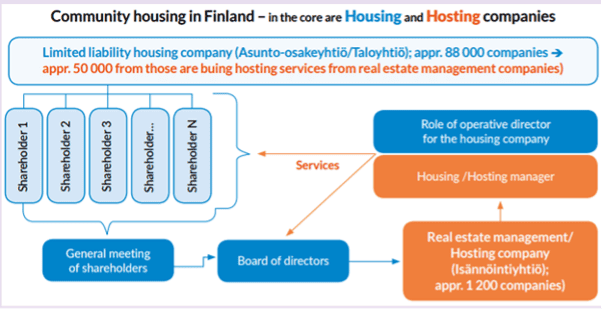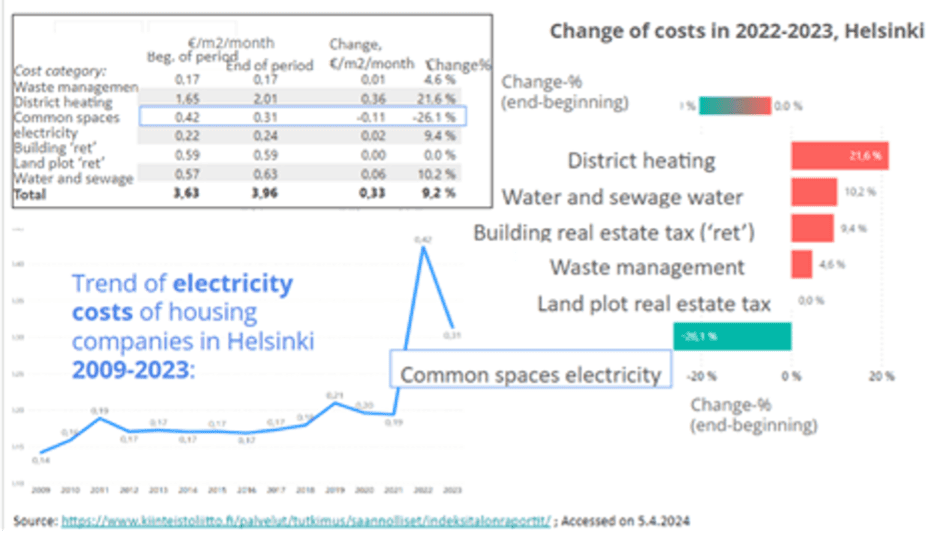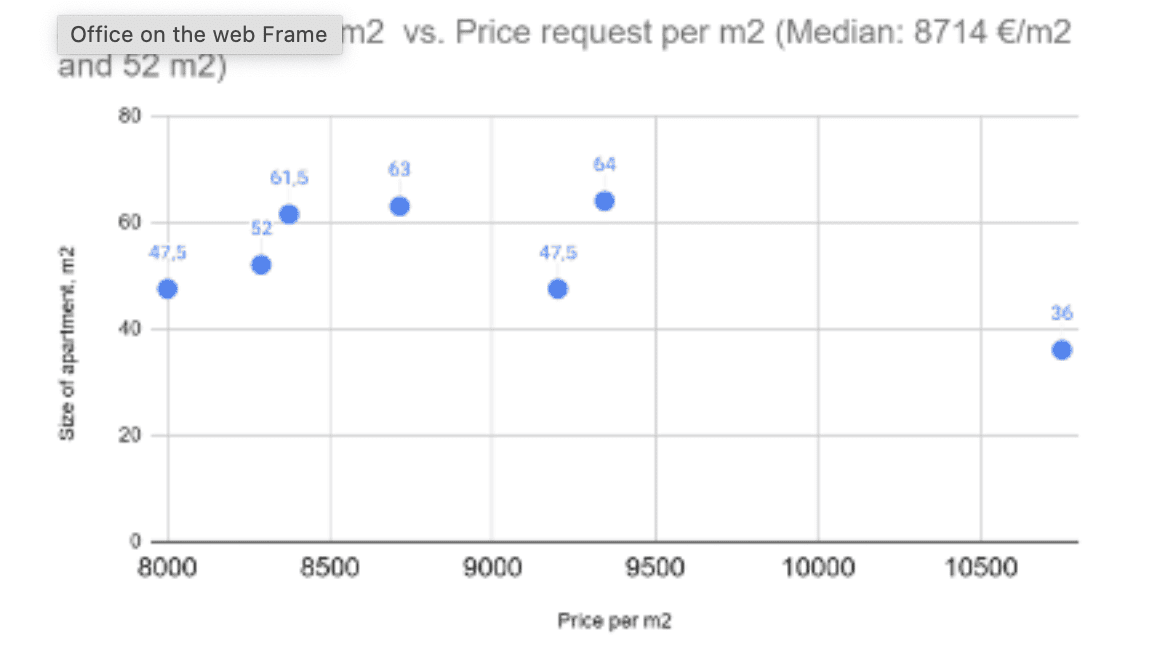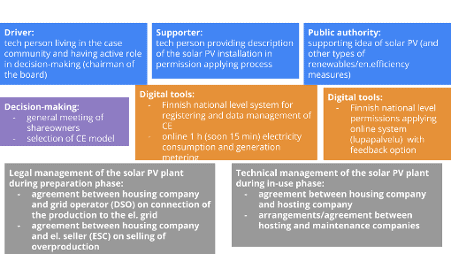
Case Study #4: Pursimiehenkatu (Finland)
04 October 2024
Author: Green Net Finland
Keywords: Historical buildings, collective self-consumption
Overview
The EC of Pursimiehenkatu is located in the center of the City of Helsinki. Pursimiehenkatu 21 is a protected building and is assessed in the site plan as a significant building in terms of the cityscape. In August 2022, the black tin roof of the protected building got completely black solar panels on its two patches.
Members of the EC are shareowners of the housing company. Finnish SME Solarvoima Ltd. had the role of consultant in the phase of establishing the EC solar park in Pursimiehen 21 housing company. A description of the solar PV installation was provided as an attachment to the permit application.
This EC case is selected as a good practice for two reasons:
- Pursimiehenkatu 21 is a protected building. There is a common narrative that installing new technologies (incl. solar parks) in such buildings is challenging due to difficulties in obtaining permissions.
- There is a working model for electricity sharing and refund calculation.
In the refund calculation, the solar electricity that exceeds the electricity consumption of the housing company is first distributed to the electricity consumption of the apartments, and only the solar electricity that exceeds this is sold to the electricity grid. The refund calculation enables the enlargement of the solar power plant without increasing the proportion of solar electricity sold to the electricity grid. In this way, the financial significance of the solar electricity system increases, and the profitability improves.
Legal form
Fingrid – national grid operator – and its daughter company DataHub are bodies overseeing all ECs in Finland.
The legal form of this EC is ‘limited liability housing company’ (orig. asunto-osakeyhtiö). It did not change. In the case of changing ownership of an apartment, the new owner becomes also a shareholder and through this a member of the EC.
General info about housing companies in Finland:
- Management and ownership of housing or residential real estate properties in Finland have a few models. One of them is the ‘ownership by shareholders’ model.. At the core of this model is a limited liability housing company (further in the text – housing company), which is a single legal body, owning the whole property/building; it also owns the apartments themselves.
- In Finland are approximately 88,000 housing companies. As a rule, costs in the housing company are distributed on a consideration basis following the Housing Companies Act (1599/2009). This means that the costs are distributed among the shareholders following the basis for payment per square meter or share.
So-called ‘articles of association’ are an internal law of the housing company and must be held by every housing company per the Housing Companies Act (1599/2009). The articles of an association are approved by the annual general meeting and should be registered. They define the basis on which the shareholders pay remuneration, and on which premises the shareholder’s shares are given the right to manage the company. It is also possible to find out from the association’s articles how maintenance responsibilities are divided between the shareholder and the housing company.
However, the permit bureaucracy was handled surprisingly smoothly. Fränti uploaded the project information and the observation photos of the solar electricity survey to the Lupapiste.fi web service, and in less than a month, the statement from the building inspectorate arrived: “Construction work does not require a permit according to Section 126 a of the MRL.”
Info about ‘MRL’
- Behind the abbreviation is ‘Maankäyttö- ja rakennuslaki ’ (Land Use and Building Act).19
- The new title is the Area Use Act (orig. Alueidenkäyttölaki) from 1 January 2025.
- This law aims to organize the use and construction of areas in such a way that it creates the conditions for a good living environment and promotes ecologically, economically, socially and culturally sustainable development. The goal is also to secure everyone’s opportunity to participate in the preparation of matters, the quality and interactivity of planning, the versatility of expertise, and open information on the matters under discussion.20
- Section 126a (21.12.2012/958) ‘Procedures subject to a procedure permit’:
- 12) drilling a thermal well intended for the utilization of ground heat or installing a heat collection pipeline when replacing or renewing the building’s heating system or for use as an additional heat source (ground heat); (21.4.2017/230)
- 13) installing or building a solar panel or collector that significantly affects the cityscape or the environment. (21.4.2017/230)
- If the measure referred to in paragraphs 1–10, 12 or 13 of subsection 1 is based on a formula or street plan with legal effect or on an approved road plan following the Highways Act or the Act on Public Roads (243/1954), a permit for the measure is not required. (21.4.2017/230)
- The municipality can stipulate in the building order that a measure permit is not required in the municipality or part of it for the measure referred to in paragraphs 1–10, 12 or 13 of subsection 1, if the measure can be considered minor. (21.4.2017/230).21
“We in construction supervision are doing everything we can to ensure that solar power plants are placed on the roofs of Helsinki. We only look behind them to the extent that they are discreet in terms of cityscape and the installations are technically safe,” says architect Ulla Vahtera, who handles the solar panel project on Pursimiehenkatu.
Helsinki’s building control almost invariably interprets solar panel installations as minor measures, in which case the permit required by law is not even required. Helsinki’s current building order exempts all solar panels placed on roofs from a permit, but building protection requirements must be considered. On Pursimiehenkatu, the building inspection required that all-black panels be installed on the roof of the protected building, which color-matched well with the black tin roof.
Technological setup
The installation of the black solar panels on the rooftops of Pursimiehenkatu 21 followed the regular steps. Data on electricity generation and usage is available only for the housing company (EC owner), DSO and the electricity supplier.
Before connecting solar PV systems to local DSO Helen Sähköverkko Ltd., one must fill out a form, which is available online.The form is used to inform Helen Sähköverkko Oy about devices with a nominal power of less than 50 kW for connecting the production plant and/or electricity storage to the electricity grid. The form is filled out by the organization/company connecting electrical power before starting electricity production, in addition to sending this form to get a connection permit from Helen Sähköverkko Oy and to make a purchase agreement with an electricity supplier seller company.
Solar panels in apartment buildings are routine, which are quickly processed as requests for advice. Helsinki’s building control is mostly employed by heat recovery devices for the ventilation of apartment buildings and heat pump installations. “If there is no shading, then the roofs will be full of solar panels,” says Harri Fränti, chairman of the board of Pursimiehenkatu 21.
Governance
The City of Helsinki encourages building societies to carry out energy renovations. If you are planning a solar power plant on the roof of the house, the construction of heat recovery or an air-water heat pump installation in the courtyard, the first step is to contact the city’s building control at the Lupapiste.fi service. “It’s a good business tool. All information is archived there, both for the representatives of the housing company and for the use of the energy advisory team of the City of Helsinki,” says permit handler Ulla Vahtera.27
The managing body of block of flats buildings (assets) in Finland is hosting companies (orig. isännöintiyhtiö). Technical maintenance of blocks of flats in Finland is under the responsibility of the hosting and maintenance companies (orig. huoltoyhtiö). Hosting and maintenance companies are selected by the housing companies. The Figure below demonstrates the schema of relations between housing and hosting companies.
Business model
The installation cost was about 30 000 euro. It was financed by selling the caretaker’s apartment. No public funding was used.
Although the 26 kW high-power solar power plant was commissioned only at the end of August 2022, it managed to generate electricity sales income of almost 2,000 euro for the housing company during the autumn months, thanks to the peak spot prices of electricity on the stock exchange. “If we had already put the panels into production as planned in May, we would have sold electricity for up to 5,000 euro”, thought Harri Fränti.
One of the aspects influencing the feasibility of EC solar park is the electricity costs of the housing company. The next Figure demonstrates changes in electricity costs in 2022-2023 for housing companies in Helsinki generally. After peak costs in 2022, electricity costs decreased by 26%.
“The power plant produces about 20 megawatt hours of electricity a year,” says Harri Fränti. It is many times as much as the consumption of an old stone house that relies on gravity ventilation. Therefore, most of the electricity produced ends up being sold.
Data on electricity generation and usage is available only for the housing company (EC owner), DSO (distributor) and the electricity supplier.
Social inclusion
Mitigation of energy poverty does not seem to be relevant for this EC. Electricity bills decreasing due to solar park is a relatively small matter if to look at apartment prices in the case of housing companies. The median price is about 8 700 euro/m2 or 437 000 euro for the apartment.
The leader of the housing company of Pursimiehenkatu 21 is the chairman of the board and has a technical background. He is working as an educator at Taitotalo, which is Finland’s leading vocational adult education centre, serving the educational and training needs of over 20 000 adults every year.32 “I work as a trainer in the field of building technology and housekeeping. Energy efficiency, Lean issues and Last Planner are also close to my heart”, states Harri Fränti.
References
Finlex. 1999. “Ajantasainen Laki: 132/1999.” Finlex.fi. https://www.finlex.fi/fi/laki/ajantasa/1999/19990132. Accessed on 5.4.2024
Helen Sähköverkko. 2023. “Jakeluverkkoon Liitetyn Tuotantolaitoksen Yleistietolomake.” Helen Sähköverkko. https://www.helensahkoverkko.fi/globalassets/hsv/hsv-pdf/ohjeet/jakeluverkkoon_liitetyn_tuotantolaitoksen_yleistietolomake4.pdf. Accessed on 5.4.2024
GNF. 2022. “Overview of Municipal Solid Waste Management in Finland.” GNF.fi. https://gnf.fi/wp-content/uploads/2022/12/Overview-of-municipal-solid-waste-management-in-Finland_FINAL.pdf.
Helsinki. 2023. “Pursimiehenkatu 21 – Aurinkopaneelit.” Energiaremontti.hel.fi. https://energiaremontti.hel.fi/taloyhtioiden-esimerkit/pursimiehenkatu21-aurinkopaneelit/. Accessed on 3.4.2024
Helen Sähköverkko. 2023. “Jakeluverkkoon Liitetyn Tuotantolaitoksen Yleistietolomake.” Helen Sähköverkko. https://www.helensahkoverkko.fi/globalassets/hsv/hsv-pdf/ohjeet/jakeluverkkoon_liitetyn_tuotantolaitoksen_yleistietolomake4.pdf.
Helsinki. 2023. “Pursimiehenkatu 21 – Aurinkopaneelit.” Energiaremontti.hel.fi. https://energiaremontti.hel.fi/taloyhtioiden-esimerkit/pursimiehenkatu21-aurinkopaneelit/. Accessed on 3.4.2024
Motiva. 2023. “Aurinkosähkö Taloyhtiössä.” Motiva.fi. https://www.motiva.fi/koti_ja_asuminen/energiatehokas_taloyhtio/aurinkosahko_taloyhtiossa. Accessed on 3.4.2024
Kiinteistöliitto. 2023. “Indeksitalon Raportit.” Kiinteistöliitto.fi. https://www.kiinteistoliitto.fi/palvelut/tutkimus/saannolliset/indeksitalonraportit/. Accessed on 5.4.2024
Taitotalo. 2023. “Harri Fränti – Asiantuntijat.” Taitotalo.fi. https://www.taitotalo.fi/asiantuntijat/harri-franti.
Taitotalo. 2023. “Taitotalo Provides Skills for an Ever-Changing World.” Taitotalo.fi. https://www.taitotalo.fi/tama-taitotalo/taitotalo-provides-skills-ever-changing-world. Accessed on 4.4.2024














